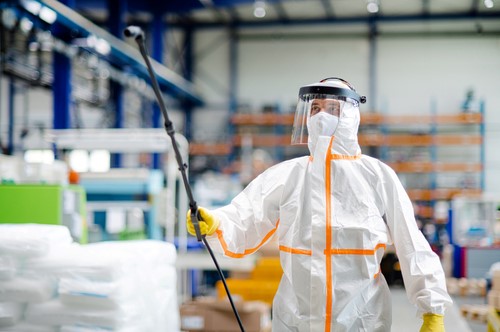
by Jennifer Hart Yim | Aug 5, 2020 | Blog, Covid-19
Editor’s note: This is the first in a series of three guest posts by Kate Began of Polycase.
The Covid-19 outbreak has changed the global business landscape in ways that would have seemed unbelievable just a few months ago. Businesses have been forced to reevaluate their approach to everything–from sourcing to operations. The manufacturing industry has seen particularly high levels of disruptions as plants are temporarily shut down and supply chains are disrupted.
A few months into the pandemic, trends have begun to emerge that allow the business community to begin to analyze Covid-19’s impact on American manufacturing. While supply has been constricted on everything from electronics enclosures to pharmaceuticals, demand has mutated in unpredictable ways, and businesses are scrambling to find new strategies for addressing these challenges.
These five aspects have already created major change in the manufacturing economy, and manufacturers will need to face them head-on to create a plan for surviving the continuing challenges of the post-pandemic business landscape.
1. Quarantines and shutdowns have caused some major hits to the bottom line for the American manufacturing industry.
Many U.S. manufacturers were forced to shut down as a result of the “stay-at-home” orders that their states imposed in March and April of 2020. Those that weren’t required to shut down often had to produce at reduced capacity, thanks to lower demand in many industries (as we’ll discuss later).
The result has been dramatic: an estimated 25 percent decrease in yearly profit predictions for the American manufacturing industry. While it’s true that manufacturers in some sectors, such as CPGs and medical equipment, have seen enormous spikes in demand, the overall financial picture for the manufacturing sector (particularly heavy industry) remains disturbing.
Having taken such a painful hit to the bottom line, many manufacturing businesses find themselves limping into Q3 and in need of a new plan for finishing out the year. Easy answers will be in short supply, but manufacturers will need to take decisive action to prevent a bad situation from becoming worse.
2. The devastating impact of lax safety procedures has become apparent.
American manufacturing businesses have to face the facts: During a pandemic, inaction is deadly. We’ve seen uncontrolled outbreaks sweep through meat-packing facilities across the nation, killing dozens and sickening thousands more. While it’s true that meat-packing plants are uniquely vulnerable to the spread of respiratory diseases, the risks apply to any facility in which workers are in close proximity to one another and/or share equipment.
Manufacturers owe it to their employees, their customers, and the world at large to ensure that their facilities don’t contribute to the spread of coronavirus. More than ever, practicing good workplace hygiene has become a matter of life and death. Businesses must be sure to follow the CDC’s guidelines for businesses and employers, and they must strictly enforce compliance among employees.
Steps as simple as requiring masks at work can significantly reduce the chances of disease spread. However, in order to truly reach the level of a responsible corporate citizen, manufacturers must commit to substantial reconfiguration of their processes to institute social distancing in the workplace.
3. Manufacturing supply chains have seen major disruptions.
The globe-crossing supply chains that characterize 21st-century commerce have had their reliability severely tested by the pandemic. China, in particular, has experienced major logistics problems, such as closed ports and grounded flights. With so many of the world’s manufacturing supply chains running through China, many businesses have had to find creative ways to keep their operations running.
Business experts say that this global supply chain chaos has been a major learning experience for manufacturers, who were often caught without sufficient options when their Chinese supply chains began to collapse in February and March. Going forward, these businesses will have to put a new focus on diversifying their supply chains to increase their resilience to globally disruptive events such as pandemics. Those low-priced Chinese components may do great things for the bottom line, but you can’t capture any of those benefits if you can’t get the materials in the first place.
4. Demand has plummeted in some sectors (and exploded in others).
With the Covid-19 pandemic has come an economic contraction that has suddenly plunged the U.S. economy into a recession. As a result, demand has massively decreased in many key American manufacturing sectors. Industry reports demonstrate that demand for everything from heavy equipment to electronics to metal fabrication continues to experience painfully intense contractions.
The silver lining for some manufacturers is that demand has actually increased rapidly in some sectors. Food, beverage, and other essential household CPG manufacturers have all seen massive surges in demand, as have medical supply manufacturers. The demand surge has even reached some unexpected corners such as the DIY home products industry as bored, homebound Americans take on home improvement projects.
These shifts in demand have produced some fascinating examples of the versatility and agility of leading American manufacturers. Top consumer fashion brands have begun production of surgical masks and gowns, while industrial manufacturers like 3M have used their state-of-the-art fabrication facilities to produce ventilators and other key healthcare equipment.
5. Cash flow will be a major priority moving forward.
In a turbulent economy, many manufacturers are reevaluating their cash flow strategies and prioritizing liquidity. By maintaining increased cash reserve levels, manufacturers can prepare themselves better to deal with the constantly shifting nature of the Covid-19 crisis.
Bolstering cash flow effectively requires applying a finance-driven mindset across all levels and departments of a manufacturing organization. The day-to-day practice of supply chain operations tends to be conceptually grounded in inventory management and customer relationships. While these are critical facets that can’t be sacrificed, supply chain operators need to become more practiced in thinking like a CFO and seeing the financial framework that underpins logistics decisions.
However, it’s important to remember that financial concerns should never take priority over the safety of employees and customers. The ultimate goal is to create a system of operations where both employment and physical well-being are safe and well-protected.
The novel coronavirus has given the U.S. economy a massive dose of that most dangerous economic toxin: uncertainty. For manufacturers to continue to thrive and compete, they must turn that uncertainty into innovation and seize the new opportunities that this rapidly changing economy presents to them.
Kate Began serves as the Sales and Marketing Manager for Polycase. She oversees the customer service representatives, assists with product development, and leads the marketing efforts from the Avon, Ohio headquarters. Kate is also an avid Cleveland Indians fan.
Read more:
Stop hibernating: You’re missing out on company blog benefits
When short on time, updating old blog posts for SEO makes a lot of sense
Key step to moving beyond survival mode: Revising B2B buyer personas

by Jennifer Hart Yim | Jan 30, 2018 | Blog, Current Events, Logistics, Supply Chain
Looking at Tesla’s suppy chain issues, here are the biggest takeaways so you don’t have to repeat their mistakes.
This guest post comes to us from Argentus Supply Chain Recruiting, a boutique recruitment firm specializing in Supply Chain Management and Procurement.
Back in 2016, we posted about Tesla’s ambitious plan to ramp up production of its consumer-grade Model 3 electric car to 500,000 vehicles a year by 2020. At the time, pretty much every analyst agreed that was an ambitious target for a manufacturer without solid experience mass-producing vehicles at that scale. In the two years since, Tesla’s CEO Elon Musk has issued a number of other bold predictions. He’s championed a whole host of emerging technologies. He’s made the world feel like the future could resemble a sci-fi novel – were he to deliver on the herculean tasks of sending humans to mars, shifting the world to solar power production, and figuring out how to directly connect computers to human brains.
But in the meantime, there’s also been the pesky matter of the more mundane – but seemingly no less difficult – task of delivering on the very high demand in the marketplace for Tesla Model 3s. In 2016, the company faced scrutiny for allegedly hiring 140 workers from Eastern Europe for $5 an hour. Then, in 2017, various press outlets reported on a number of issueswith the Model 3’s Supply Chain, specifically issues related to the vehicle’s battery design, as well as issues with manufacturing automation. The result?
Only 220 Model 3s were delivered as of October 2017. We’re sure the company has delivered more cars since then, but that’s a brutal statistic almost two years after over 400,000 consumers paid $1000 each to preorder the car. Investors are growing restive, with the company’s share price down 6.8%, and the company reporting a $671.1 million loss for the 3rd quarter of 2017. Musk has compared the Model 3’s current production state to the “8th circle of hell,” and acknowledged that Tesla won’t hit the goal of 5,000 units produced a month until “sometime in March 2017.”
A great article last month from CIPS’ industry magazine Supply Management dove into some of Tesla’s Supply Chain woes, discussing how the company, still considered a visionary in the industry, has got to this place, as well as some optimistic scenarios for how it can get out of it. Written by Paul Simpson, it’s an interesting account of how Supply Chain issues can stymie a company, even if that company and product have huge positive brand association. Similarly to what we did with analysis of Target’s Canadian misadventure, we wanted to see what lessons we can draw from Tesla’s Supply Chain issues that might be useful in industries other than automotive manufacturing.
Here are our biggest takeaways for what can be learned from Tesla’s Supply Chain woes:
- If you’re not confident that your production and Supply Chain are up to snuff, don’t overpromise to the consumer. Elon Musk has made a cottage industry out of bold pronouncements about the future, and he’s delivered on some of them before. It’s why he’s gained a reputation as a visionary. Musk had to know that promising to quickly scale up production to 500,000 cars a year was an unrealistic goal. He’s also someone who believes in setting big goals as a way of achieving the impossible. But even with that in mind, it’s possible he also underestimated the inevitable difficulties in mass-producing a product with 10,000 individual parts, and that’s led to way too many 2 a.m. nights tinkering with robotics on factory floors.For his part, Musk acknowledged that he’s now trying not to make pronouncements about production timelines.
- Take ownership for Supply Chain failures rather than blaming suppliers. Even if suppliers are failing to deliver, consumers (and, relevant to Tesla, shareholders) will almost always blame the company itself rather than those suppliers – and rightly so. They’re the ones who selected those suppliers, after all. In Tesla’s case, Musk took personal ownership over the decision to select the system integration subcontractor that’s behind the latest delays – instead of blaming his Supply Chain staff. Depending on your perspective, you can either look at this as a visionary CEO being transparent about Supply Chain difficulties, or a manufacturer throwing a supplier under the bus.
- Great companies need a Supply Chain guru. Simpson quotes an argument by American journalist Travis Hoium, who said that “Elon Musk Needs his Own Tim Cook to Take Over Operations.” Drawing a parallel to Steve Jobs, Hoium argues that Musk needs an operations genius who can match his vision for the future and product development excellence with Supply Chain execution. Sometimes business leaders – especially those with the vision of someone like Elon Musk – overrate their own ability to understand the intricacies of managing complex Supply Chains, to their detriment. Tesla’s issues underscore the importance of having the right talent in place to avoid the murky waters of Supply Chain failure – and figure out how to right the ship if things go awry.
Despite these numerous issues, it looks like – for now – Tesla is facing more heat from shareholders than consumers. Anticipation for the Model 3 is still high, showing that a strong product and brand can trump some Supply Chain issues. But these issues are starting to have a real impact on Tesla’s share price and bottom line, and the pressure is on. Let’s see how this story develops as 2018 proceeds.
Related posts:


by Fronetics | Dec 19, 2017 | Blog, Marketing
Email is one of the most utilized tools in your marketing toolbox, but marketers need to continuously develop their email practices to keep up with the rapidly changing interests of audiences.
Email marketing is a powerful tool for growing and developing your business. You probably get hundreds of marketing emails from all kinds of companies you patronize (and even those you don’t) every day. So you know as well as anyone that not all email marketing is created equal.
Especially in B2B culture, there is a right way — and many wrong ways — to do email marketing. Our blog hit on many best practices in 2017 that are important for B2B marketers to keep in mind as they create marketing emails.
Here are the top 7 email marketing posts for 2017.
1. 7 Email Marketing Tips for Manufacturers and Industrial Companies
Here are seven tips for manufacturers to improve your email marketing strategy in the manufacturing and industrial sector. Many manufacturers and industrial companies are still stuck in the one-off batch and blast mode of email marketing. That strategy is not likely to work very well in industrial marketing, where most of the purchases include complex products with long sales cycles, multiple decision-makers, and stakeholders are involved. Read more.
2. 7 Techniques for Personalizing Marketing Emails and Boosting Engagement
Personalizing marketing emails increases open rates, click-throughs, and revenue, but it takes so much more than addressing recipients by name. Marketers can use information they have about subscribers to tailor email content for individuals, based on who they are or where they are in the buyer’s journey. Read more.
3. 4 Email Marketing Stats that Prove You Spend Too Much Time Creating Emails
Email marketing can be a challenge — to say the least. The constantly changing email landscape, marketing trends, and privacy regulations can make staying on top of your email game very tough. Take a look at these 4 statistics and why streamlining and automating certain aspects of your email marketing program might free you up to focus on factors that can make a difference. Read more.
4. Increase Revenue from Marketing Emails by 760% with This One Trick
Email list segmentation is the one of the simplest and most critical practices to improving marketing email performance. Marketing emails are an important part of lead nurturing: They can make or break whether a lead becomes a sale. So marketers spend a lot of time and money thinking about how to perfect their messages. Read more.
5. 5 Biggest Email Subject Line Mistakes to Avoid
Email marketers, beware: If you’re tasked with writing compelling emails to capture online customers, the subject line — the headline of your message — is the first and main spot to grab the viewer’s attention. But, while a cleverly written subject can boost open rates and click-throughs, a poorly written one can have the opposite effect. Read more.
6. Three Marketing Email Crimes to Avoid
Are your marketing emails annoying your customers and prospects? We’ve all felt it: the visceral annoyance on opening an email — because it’s the fifth one from the same company in two days, or because it’s packed with hyperbole or an off-putting sales pitch. As it turns out, recent research has shown that this reaction is only too natural. We’re predisposed to view the tone of email more negatively than it was written. Read more.
7. Mobile-Friendly Emails: 6 Tips for Success
Use these 6 tips for more mobile-friendly emails to improve recipient engagement rates and to promote profitable customer action. When a majority of your audience is reading your marketing emails on their mobile devices, it’s imperative that you’re creating emails that are optimized for mobile viewing. Here are 6 essential tips for creating mobile-friendly email campaigns. Read more.
Related posts:


by Fronetics | Nov 28, 2017 | Blog, Manufacturing & Distribution, Marketing, Social Media, Supply Chain
Manufacturers who are active and engaged on Facebook are more likely to introduce product innovation than those who are not.
If you’re killing time during business hours on Facebook, you may actually be onto something valuable. Well, no, — scrolling through your sister-in-law’s vacation album is unlikely to help your business. But recent studies show that staying attuned to user feedback on Facebook may actually help manufacturers create better products.
The practice in question, social listening, is the process of monitoring social media to identify and assess what users are saying about a company, individual, brand, product, or service. We’ve written about how social listening can help your business — you can gain market intelligence and learn how your company, products, and services are being perceived.
But two researchers from the Centre for European Economic Research (ZEW) have taken things a step farther. They studied data from nearly 3,000 German manufacturing and service firms to analyze the role that Facebook plays in the innovation process. What they found was that the probability that a company introduced a product innovation was significantly determined by firms’ adoption of a Facebook page and by the activity by users, measured by both quantity and quality.
The researchers, Irene Bertschek and Reinhold Kesler, discuss their findings in detail in this article published in the Harvard Business Review. So you can skip to the bottom line, we’ve pulled out a few key takeaways for manufacturers:
Negative comments are your friend…
…if you take them seriously.
While you might cringe when you seed a negative customer comment on Facebook, what the researchers found was encouraging: “Surprisingly, only the share of negative user comments was significantly predictive of innovation, perhaps suggesting that customers were helping to steer companies away from bad ideas.”
To make this work for you, it’s important that you pay attention to negative reviews, actively engage with them, and pass along relevant information to the people within your company who can address the issues. For more ideas, check out this post for tips on dealing with negative customer comments.
Simply being on social media isn’t enough — you need to be actively and intelligently engaging.
The study found that companies who were “using keywords in their posts that encourage users to leave feedback were significantly more likely to release a new or improved product.”
In other words, to gain the kind of valuable feedback that allows your products and services to improve, you need to be intelligent about soliciting it. “When developing social media strategies,” suggest Bertschek and Kesler, “companies should not only focus on marketing aspects, but also consider the potential for the firm’s innovation success.”
Related posts:


by Elizabeth Hines | May 10, 2016 | Blog, Strategy, Supply Chain

Increasing operational expenses to avoid capital expenditures that would boost warehouse capacity and functionality might end up costing you more in the long run.
Consider this scenario: Demand is up and projected to grow for your products. But you are running out of space in your distribution center. Although you realize modernizing your distribution center to increase productivity would make sense, you resort to the seemingly more affordable solution — hiring more workers.
While many companies may balk at the upfront cost of investing in, for example, warehouse automation technology, holding off on upgrading in the name of saving money can become a costly long-term strategy.
Don’t get me wrong. Automation is not always the answer to tackling issues that stem from rapid growth, but companies need to be aware that doing nothing also comes at a cost. Increasing operational expenses to avoid capital expenditures that would boost warehouse capacity and functionality is generally not a good idea. More workers on the floor mean more congestion and delays, in addition to increasing the risk of higher turnover rates, as new employees are more likely to move on than longer-term associates.
In the end, if your productivity and order fulfillment suffer as a result of your inaction, so will your customer relationships.
FORTE, a Swisslog Company, made the following observation in SupplyChain 24/7:
Businesses routinely choose to not invest in distribution without giving careful consideration to the impact on operational costs and missed business opportunities. They thoroughly evaluate whether to purchase material handling equipment, warehouse software and distribution buildings. The same scrutiny should be applied to real and often hidden expenses and the opportunity costs of the option to do nothing.
In FORTE’s case, the company came to the “rescue” of a retailer who had planned to respond to a significant increase in demand and SKUs by hiring more workers to the tune of $900,000 to $3 million per year. Although labor costs would more than double, the retailer would still struggle to fulfill and deliver new orders on time. After much debate, senior management decided to spend $5 million on new material handling equipment and software to meet current and future demand.
So what issues can arise from the do-nothing strategy?
Well, take your pick among unwanted scenarios: Bottlenecks in pick zones; safety concerns as a result of increased congestion; double-handling due to an inability to confirm picks; discrepancies in putaway, replenishment, and picking stemming from the lack of automatic data capture and real-time tracking; and dropping productivity as employees, among other things, have to travel further to retrieve items.
If you have reached a point where you miss or ship incorrect orders, and adding labor seems to only compound the challenges, it is time to take a serious look at your priorities. Perhaps, investing in automation is finally justified?
This post originally appeared in EBN Online.
Related posts:






